State-wise major pest & diseases and their control measures
| S.No. | Pest / Diseases | Control measures |
| 1 | Stem borer (Chilo partellus & Sesamia inferens) | Management of Stem borers Farm sanitation: Removal of infested plants, ploughing the field soon after harvest and collection and burning of stubbles to kill the hibernating larvae and pupae.Growing stem borer tolerant hybrids (DHM 117).Adjusting the sowing time to avoid peak activity of the borers to coincide with critical stage of the plant (10-12 days old).Maintaining optimum plant density in the field (33,000 plants/ac).Intercropping with legumes such as cowpea, soybean, redgram and green gram in 2:1 ratio encourages the buildup of natural enemy population.Trap crop: Sorghum is the preferred host for C. partellus. Sowing 2-3 rows of trap crop on all sides of maize and uprooting it after 45 days.Clipping of lower leaves of maize on which most of the eggs are laid.Crop rotation with non-host crops destroys the buildup of pest due to non-availability of host.Release of egg parasitoid, Trichogramma chilonis @ 8 cards per ha twice i.e., at 12 and 22 days after germination.Cotesia flavipes is the dominant and most widely distributed larval parasitoid.Use of recommended dose of fertilizers, avoiding excessive use of nitrogen that increases pest attack.Prophylactic spray of Monocrotophos 36 SC @ 1.6 ml/1 or Chlorantriniliprole 20 SC @ 0.3 ml/l of water at 10-15 DAG followed by Carbofuran 3G @ 7.5 kg/ha in plant whorls in case of severity. |
| 2 | Fall Army Worm (Spodoptera frugiperda) | Integrated pest management: Summer ploughing, Intercropping with redgram/ green gram/ cowpea 2:1 or 4:1 ratio, selection of single cross hybrid, seed treatment Cyantraniliprole 19.8% + Thiomethoxam 19.8% @ 4 ml per kg seed, Erection of pheromone traps @ 4/acre soon after sowing for monitoring, Erection of bird perches @ 15/acre during early stage of the crop, application of balanced fertilizers (NPK @80:24:20), clean cultivation upto 45 days after sowing (DAS). Further, on observation of pest in the field or moth catches in pheromone traps, a window based IPM approach has resulted good control. First window (0 to 30 days old crop, highly venerable stage): Need based application of Neem formulation (Azadiractin, 1500ppm) in whorl @ 5 ml /l of water or release of Telenomus remus or Trichogramma pretiosum @ 50,000/ac at weekly intervals soon after observation of egg masses in the field and Whorl application of Metarhizium @ 5 g/liter of water for control of early instar larvae (5-10% damage). Need based application of Emamectin benzoate 5 SG in whorl @ 0.4 g per liter of water for early instar larvae (5-10% damage) and or Chlorantraniliprole 18.5% SC @ 0.4 ml/l or Spinetoram 0.5 ml/l of water / Application of Sand + lime (9:1 ratio) in whorl @ 10 kg per acre (damage >20%). Second window, Mid whorl to late whorl stage (31-65 old crop, venerable stage): Need based application of above mentioned control methods (1st window) one or two times for management of FAW in 2nd window or Apply poison bait in whorls for the control of grownup larvae with thiodicarb@100 g/ac (10 kg rice bran + 2 kg joggery + 2-3 l of water, after mixing thoroughly keep for fermentation and then mix 100 g of thiodicarb before application). Third window Flowering to grain hardening stage (>65 old crop): Insecticidal spray is not cost effective at this stage, Hand picking and killing of larvae is the best option. Two to three interventions are required during crop growth period (1st & 2nd window) for effective control of Fall Army Worm. |
| 3 | Post Flowering Stalk Rots caused by Cephalosporium maydis, Macrophomina phaseolina, Fusarium verticilloids | Crop rotation, removing plant debris, summer ploughing, application of balanced K fertilizer, avoiding moisture stress after flowering and growing tolerant hybrids |
| 4 | Downy mildews (Pernosclerospora/Sclerophthora) | Management: Cultivation of resistant hybrids Deep summer ploughing Removal of collateral and wild hosts in and around field Rouging of infected maize plants and burn them Seed treatment with Metalaxyl at 4 g/kg and foliar spray of Metalaxyl at 2g/l |
| 5 | Erwinia Stalk Rot | drenching with bleaching powder @4-5 kg/ac |
Crop production technologies:
- Plant population density (83,333/ha) is standardized by adopting a spacing of 60×20 cm for achieving higher productivity
- Standardized fertilizer requirement for normal corn for both the season 200 N, 60 P and 50 K kg ha-1 for Kharif and 240 N, 80 P and 80 K kg ha-1 for Rabi
- Post emergence herbicide molecule viz., Tembotrione (120 g/ha) was evaluated for control of all types of weeds in kharif maize at 25 DAS.
- Glyphosate 1.0 kg a.i.ha-1 as pre plant (2 days before planting) followed by 2,4-D Sodium salt 0.4 kg a.i.ha-1 as post-emergence at 25 DAS control diverse weed flora in rice-maize system under zero-tillage conditions
- Studies on Tillage management, plant density, geometry and fertility levels and zinc use efficiency on the productivity of maize under rice-maize system
- Phosphorus and Zinc requirement to maize in High “P” soils
- Maize grown in high P soils (63kg ha-1P2O5) also responded to soil application of phosphorus fertilizer (80 kg ha-1 P2O5) during Rabi season in maize-maize cropping sequence. However, in succeeding crop (Kharif season) with (60 kg ha-1 P2O5) and without phosphorus fertilizer application, resulted similar maize yields. In the same soils, having zinc (0.70 mg kg-1 soil) also required zinc application (50 kgha-1) to realize higher yields in Rabi season.
- Package of practices were developed for sweet corn and popcorn
- Studies on Soil Test Crop Response (STCR), Site Specific nutrient management (SSNM) for normal and zero tillage maize
Crop protection Technologies:
Insect pests:
- IPM module was developed for stem borers (Chilopartellus and Sesamia inferens) in maize
- Validated IPM module for management of Fall Army Worm.
- IPM practice like summer ploughing, Intercropping with redgram, green gram, black gram or cowpea 2:1 ratio, selection of single cross hybrid, seed treatment Cyantraniliprole 19.8% + Thiomethoxam 19.8% @ 4 ml per kg seed, Erection of pheromone traps @ 4/acre soon after sowing for monitoring, Erection of bird perches @ 15/acre during early stage of the crop, application of balanced fertilizers (NPK @80:24:20), clean cultivation upto 45 days after sowing (DAS). Further, on observation of pest in the field, a window based IPM approach as resulted good control.
- Need based application of Neem formulation (Azadiractin, 1500ppm) @ 5 ml /l of water soon after observation of egg laying in whorl or release of Telenomus remus or Trichogramma pretiosum @ 50,000/ac at weekly intervals (soon after observation of egg masses in the field) and Whorl application of Metarhizium @ 5 g/liter of water soon after observation of early instar larvae (5-10% damage).
- Need based application of application of Emamectin benzoate 5 SG 0.4 g per liter of water in whorl soon after observation of early instar larvae (5-10% damage) and or Chlorantraniliprole 18.5% SC @ 0.4 ml/l or Spinetoram 0.5 ml/l of water (damage >20%) or Application of Sand + lime (9:1 ratio) in whorl @ 10 kg /acre.
- A new molecule, Chlorantriniliprole was evaluated and spraying of Chlorantriniliprole @ 0.3 ml/l of water or 150 ml/ha on 10-15 days old crop for control of stem borers
- A new molecule, Flubendiamide was evaluated and spraying of Flubendiamide 480 SC @ 0.2 ml/l of water on 12-15 days old crop was recommended for control of pink stem borer
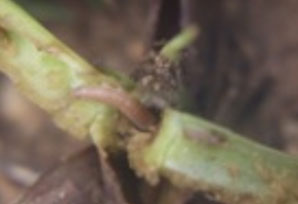
Pink stem borer 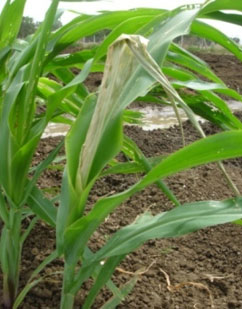
Dead heart caused by Stem borers 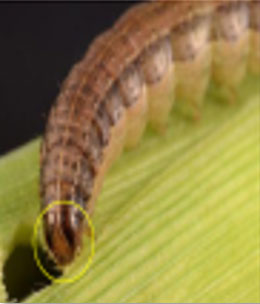
Fall Army Worm 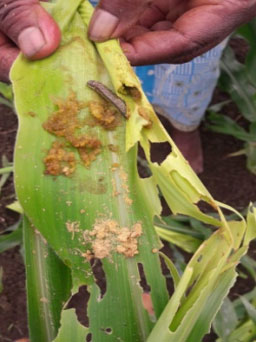
FAW damage
Diseases:
- Identified integrated disease management practices for post flowering stalk rot through cultural, bio-control and chemical methods.
- Seed treatment of Metalaxyl 4 g/kg seed is recommended for control of downy mildew followed by spraying of Metalaxyl @2 g/lt of water when the disease appears in the field.

Stalk rots 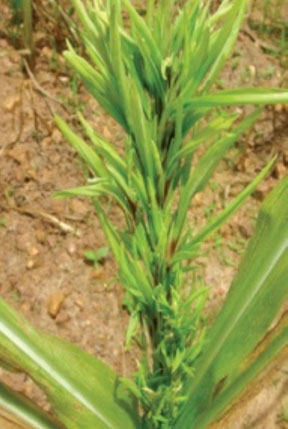
Downy mildew

